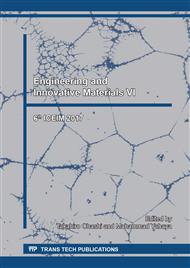p.325
p.332
p.337
p.342
p.347
p.352
p.359
p.364
p.369
Use of Thiols to Enhance the Hydrophobicity of Silver Nanoprisms
Abstract:
Silver nanoprisms, a kind of silver nanoparticles (NPs) synthesized by chemical reduction in water phase and treated with the light irradiation, have special optical properties and can be used as optoelectronic materials. However the hydrophilic property of silver nanoprisms suppresses their applications. In this study, thiols were used to modify the surface of the silver nanoprism to enhance its hydrophobicity. The ultraviolet-visible spectrometry (UV-Visible) was used to explore the surface properties of the NPs. Experimental results showed that the addition of a long chain thiol (pure 1-undecanthiol) to the water solution of silver nanoprisms gave a red shift in the absorption spectra in comparing with that of original silver nanoprisms colloid. It is due to the absorption of the thiol to surfaces of the NPs. The absorption of the long chain thiols can turn the hydrophilic surface to be hydrophobic. The NPs treated with the cracking rubber oil had the similar results. It is believed that the cracking rubber oil can be a feasible agent to enhance the surface hydrophobicity of silver nanoprisms.
Info:
Periodical:
Pages:
347-351
Citation:
Online since:
January 2018
Authors:
Keywords:
Price:
Сopyright:
© 2018 Trans Tech Publications Ltd. All Rights Reserved
Share:
Citation:


